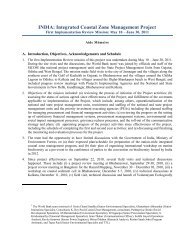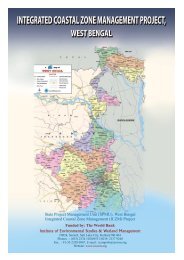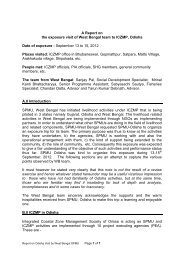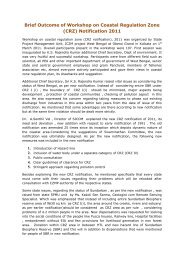Cyclone and Storm Surge - Iczmpwb.org
Cyclone and Storm Surge - Iczmpwb.org
Cyclone and Storm Surge - Iczmpwb.org
Create successful ePaper yourself
Turn your PDF publications into a flip-book with our unique Google optimized e-Paper software.
2.46<br />
The other type of failure may occur due to reasons like the presence of excess pore pressure<br />
generated by a quick falling river water level. When a bank fails in this kind of geotechnical mode, the<br />
probable slip lines or slip circles may be predicted, which depends also upon the type of material<br />
forming the banks.<br />
2.7.2. Embankments/dykes <strong>and</strong> their failures<br />
Agriculture is carried behind the nearly 3500 Kilometer of protective earthen embankments. Those<br />
are constructed by local earth of surface layers which consist mostly of very fine coherent. It is<br />
generally of low liquid limit. This soil has got the property of low erosion resistance because this<br />
material becomes liquid in coming with contact with water. Previously a forest belt of minimum width<br />
of 100 meter was kept as Foreshore l<strong>and</strong> in aligning on the embankment for the purpose of damping<br />
the wave action. But by this time the increase of population <strong>and</strong> want of fuel has caused unregulated<br />
felling <strong>and</strong> now practically there is no protection to embankment from high waves <strong>and</strong> suiting<br />
currents.<br />
These dykes were originally constructed by the Latdars with the gradual rise of high water level over<br />
the years; the Latdars increased the height of the dykes correspondingly. The constant erosion of the<br />
soil due to wave wash was also attended by them. But since late forties of this century the Latdars<br />
started neglecting the maintenance due to rise in labour cost as well as the apprehension of<br />
imminent state purchase of the Latdar's interest. The dykes at the time of taking over by the Irrigation<br />
Department in 1960 were found to have inadequate section <strong>and</strong> strength. Breaches <strong>and</strong> overtopping<br />
was of quite common phenomenon.<br />
Due to paucity of funds, this enormous length of embankments could not furthermore be brought to<br />
adequate section <strong>and</strong> height to ensure safety. In many cases these dykes are aligned bordering the<br />
scouring bank of me<strong>and</strong>ering rivers. This necessitated another set of embankments, some dist<br />
inl<strong>and</strong>, called the retiring embankments.<br />
Generally during flow tide accompanied strong southerly wind from second fortnight, of March, to<br />
October, the river water splashes over the earthen embankment causing continuous erosion of soil.<br />
This phenomenon occurs twice a day <strong>and</strong> the poor soil give very little resistance to it. On an average<br />
two major tropical cyclonic storms occur in each year in Sundarbans. During such cyclone storms<br />
high waves are generated in sea face <strong>and</strong> which attack on the embankments at great storm velocities<br />
<strong>and</strong> thus overtop embankment without free board, erode river side slope <strong>and</strong> crest <strong>and</strong> cause breach.<br />
For want of cover protection works (Brick or Brick Block Revetment works) in strength of vulnerable<br />
zone, the breach cannot be prevented.
















